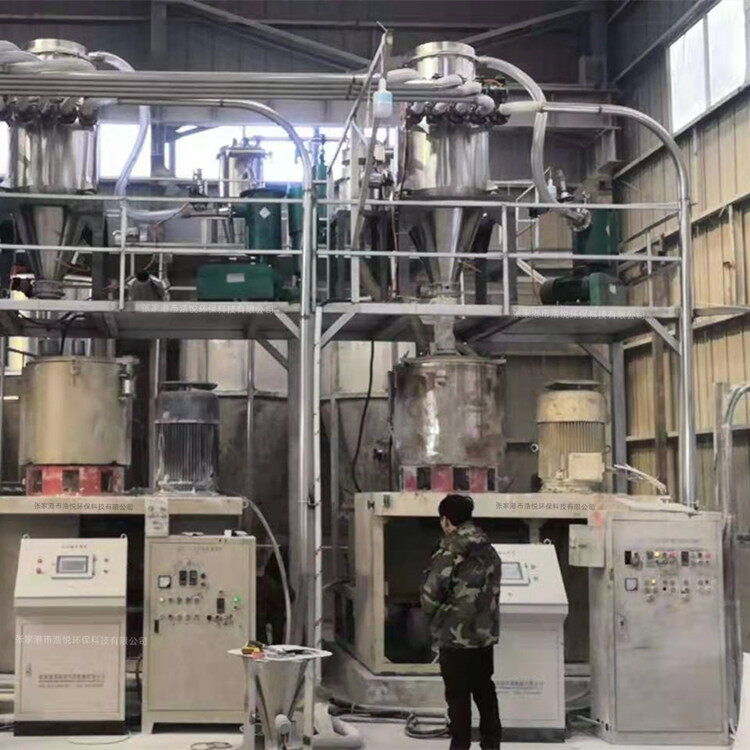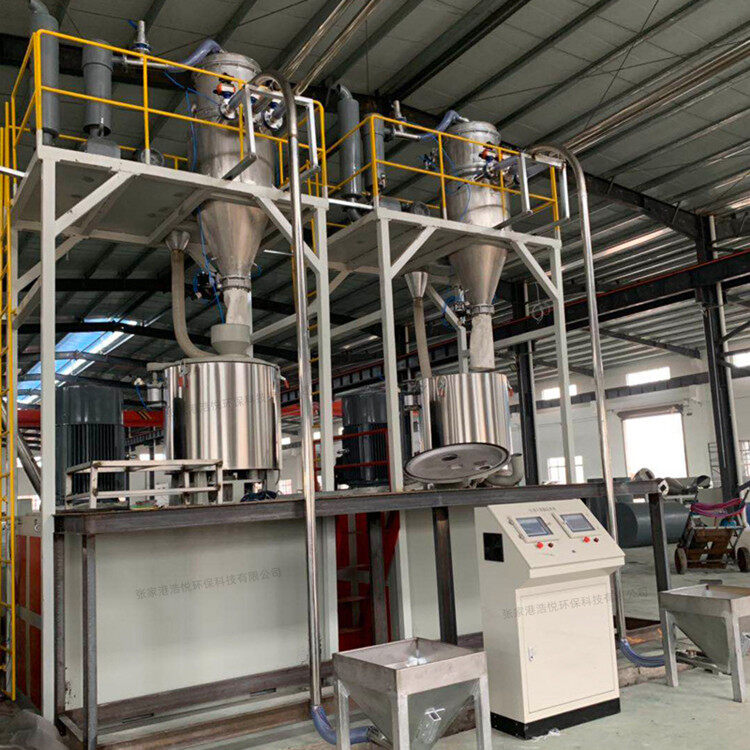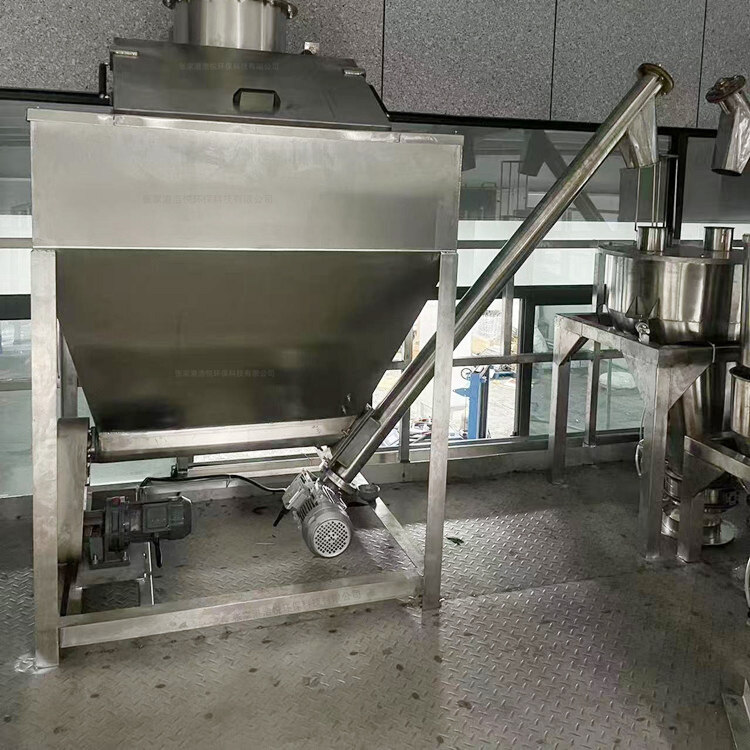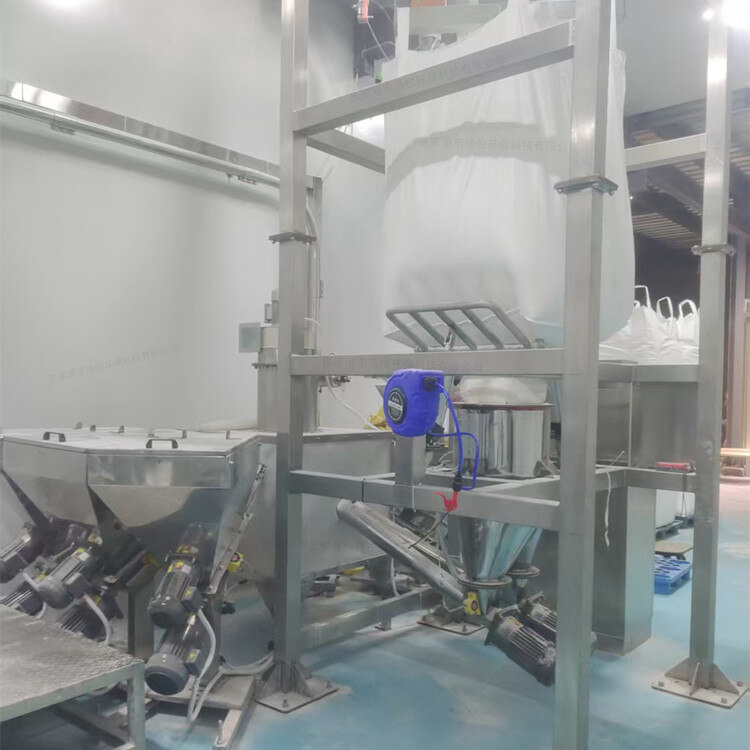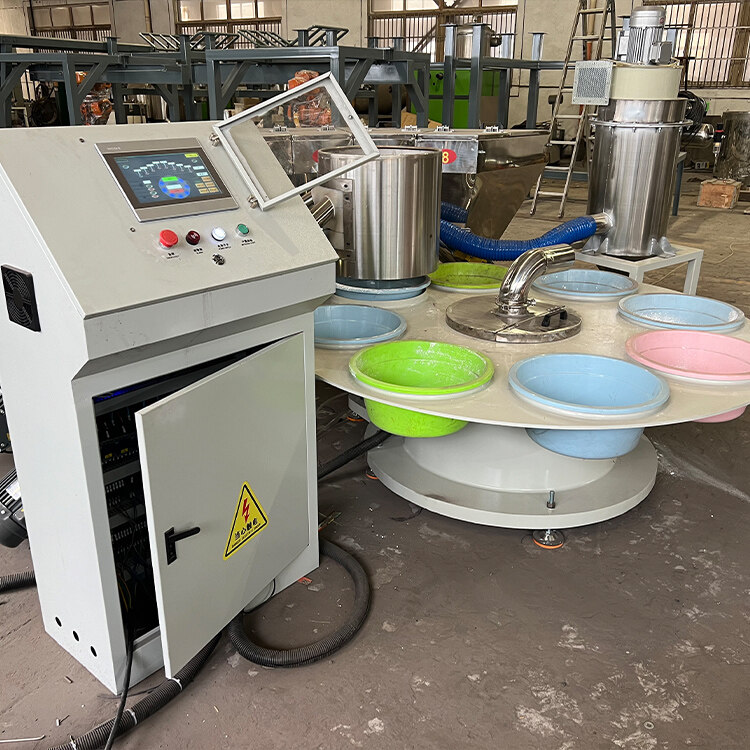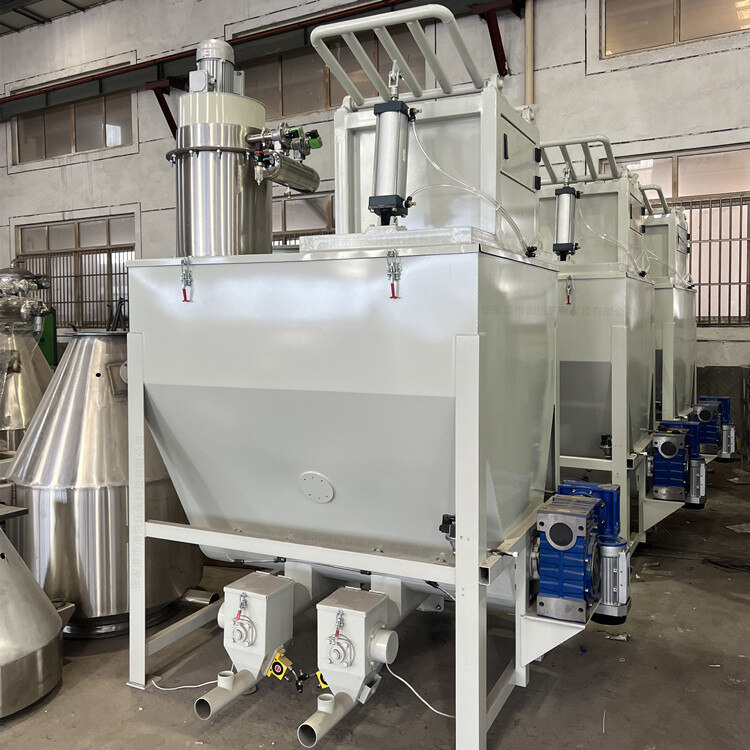- Introduction to automatic batching machine and fully automatic batching machine equipment
- The powder metering system tells you about the introduction of the mixing and drying machine
- 1000kg vacuum feeding machine
- Fully automatic small material batching system
- Research on Innovation of Automatic Weighing Machine Technology
- Design and operation of automatic batching system using PLC, industrial computer and frequency converter
Cable material vacuum feeding system
- Category:Automatic metering and conveying equipment
- Hits:114次
- Release Date:2025-06-30
- Share:
- Inquiry
- Details
In modern industrial production, efficient material transportation is a key link to ensure production continuity. As a device that utilizes the principle of vacuum negative pressure to transport materials, vacuum conveyors are widely used in industries such as food, pharmaceuticals, chemicals, and lithium batteries that require strict conveying environments due to their advantages of dust-free, high-precision, and low-energy consumption. The following will provide a comprehensive and in-depth introduction to vacuum conveyors from the aspects of equipment principles, structural composition, core advantages, application scenarios, and development trends.
1、 Working principle and core structure
(1) Principle of vacuum conveying
The vacuum conveyor is based on the Bernoulli principle, which creates negative pressure (usually -30kPa to -80kPa) in the conveying pipeline through a vacuum pump or fan. It uses the pressure difference between atmospheric pressure and negative pressure in the pipeline as power to suck materials in from the feed inlet and transport them along the pipeline to the designated location. When the material reaches the discharge bin, negative pressure is eliminated through vacuum breaking devices (such as pneumatic butterfly valves, pressure release valves), and the material is discharged under the action of gravity, completing one conveying cycle. The entire process can be divided into three stages: suction, conveying, and unloading, which are fully automated through a PLC control system.
(2) Core structure composition
Vacuum generating device
Usually, Roots vacuum pumps, rotary vane vacuum pumps, or centrifugal fans are used, and different power equipment is selected according to the conveying capacity and distance. Roots vacuum pumps are suitable for high flow, long-distance transportation (up to 100 meters or more), while centrifugal fans are more suitable for low flow, short distance scenarios (generally ≤ 30 meters). Some explosion-proof scenarios may use water ring vacuum pumps to avoid safety hazards caused by static electricity.
Transportation pipeline system
Made of 304/316L stainless steel or food grade engineering plastic material, the inner diameter of the pipeline is designed to be 50-150mm according to the material characteristics (particle size, flowability). The pipeline connection is sealed with quick release clamps or flanges to ensure stable vacuum degree and easy disassembly and cleaning. The curved section adopts a large curvature radius design (R ≥ 3D) to reduce material accumulation and pipeline wear.
Feeding and unloading unit
Feed inlet: equipped with pneumatic flap valve or star shaped unloader to prevent air backflow during suction. For manual feeding scenarios, there are ergonomically designed feeding hoppers, and some high-end models integrate dust removal filters to avoid dust during feeding.
Unloading bin: Equipped with a built-in vacuum breaking device and level sensor, it automatically stops suction when the material reaches the set height. The discharge door adopts pneumatic butterfly valve or slide valve to ensure complete discharge of materials and residual amount ≤ 0.1%.
Filtration and dust removal system
Install high-precision filter cartridges (with a filtration accuracy of 0.1-1 μ m) on the top of the unloading bin, commonly made of polytetrafluoroethylene (PTFE) or coated polyester fibers, to prevent fine dust from entering the vacuum pump. Equipped with pulse blowback device (compressed air 0.4-0.6MPa), regularly clean the surface dust of the filter element to ensure stable vacuum degree.
control system
With PLC as the core and a touch screen human-machine interface (HMI), parameters such as suction time, blowback frequency, and conveying interval can be set. Support integration with DCS systems to achieve remote monitoring and data recording, meeting compliance requirements such as GMP and FDA.
2、 Classification and Technical Characteristics
(1) Classified by transportation method
Intermittent vacuum conveyor
Features: Batch transportation is achieved through periodic start stop, suitable for switching between small batches and multiple varieties of materials, such as laboratory preparations and additive dispensing.
Typical application: Accurate proportioning of APIs and excipients in the pharmaceutical industry, with a single delivery capacity of 5-50kg.
Continuous vacuum conveyor
Features: Adopting a dual compartment design or multi-stage series connection, achieving 24-hour uninterrupted conveying, with a conveying capacity of up to 1-50 tons/hour.
Typical application: Continuous production of lithium battery positive and negative electrode materials, combined with twin-screw extruder to achieve production line linkage.
(2) Adapt according to material characteristics
Powder vacuum conveyor
Technical advantages: For ultrafine powders with D50 ≤ 10 μ m (such as carbon black and titanium dioxide), the Venturi effect is used to enhance the suction capacity, and the inner wall of the pipeline is polished (Ra ≤ 0.8 μ m) to prevent material hanging. It is suitable for high-precision scenarios such as electronic slurries and catalysts.
Particle vacuum conveyor
Design points: For particles with a diameter of 0.1-10mm (such as plastic particles and grains), large pipe diameter conveying (≥ 80mm) and low flow rate design (10-15m/s) are adopted to reduce particle collision and breakage, suitable for conveying food particles and engineering plastics.
Mixed material conveyor
Innovative design: Equipped with a cyclone separator to pre separate large particles, and then capture fine dust through a filter element, suitable for waste recycling, ore powder and other complex materials, with a separation efficiency of ≥ 99.5%.
3、 Core technological advantages
(1) Dust free conveying benchmark
Fully enclosed system: The entire process from feeding to unloading is sealed, with a workshop dust concentration of ≤ 2mg/m ³, meeting pharmaceutical grade cleanliness requirements. A case study of a certain milk powder factory shows that compared to traditional belt conveyors, dust emissions are reduced by 90%, and the risk of microbial contamination is reduced by 75%.
Anti static design: The inner wall of the pipeline is coated with a conductive layer (surface resistance ≤ 10 ⁶ Ω), and the filter element is made of conductive fibers to prevent static electricity generated by powder friction. It is suitable for flammable and explosive scenarios such as lithium battery positive and negative electrode materials.
(2) High precision conveying control
Weightless measurement integration: By linking weighing sensors with vacuum conveying, a measurement accuracy of ± 0.5% is achieved, replacing traditional volumetric measurement. For example, after a chemical enterprise used a vacuum conveyor, the error of additive addition decreased from ± 2% to ± 0.3%.
Residual free design: The cone angle of the discharge bin is ≥ 60 °, and the pipeline adopts inner wall electrolytic polishing (Ra ≤ 0.4 μ m). The residual amount during CIP cleaning is ≤ 0.05%, which meets the strict requirements of FDA for drug production.
(3) Energy saving and low maintenance
On demand energy supply: The vacuum pump speed is controlled by frequency conversion, and the energy consumption is automatically adjusted according to the conveying volume, saving 30% energy compared to traditional positive pressure conveying. According to data from a certain food factory, the annual electricity consumption has decreased from 120000 kWh to 84000 kWh.
Long life design: The filter cartridge has a pulse blowback life of ≥ 100000 times, and the vacuum pump is designed with oil-free lubrication, extending the maintenance cycle to 6000 hours and reducing downtime costs.
4、 Typical application scenarios
(1) Pharmaceutical Industry - A Model of Aseptic Delivery
In the vaccine production workshop, the vacuum conveyor is used for API transportation of sterile powder injections. The equipment material is made of 316L stainless steel and electro polished, with a surface roughness Ra ≤ 0.2 μ m. It is equipped with online sterilization (SIP) function and meets the requirements of ISO Class 5 cleanroom. After a biopharmaceutical company introduced the system, the cross contamination rate between batches decreased from 0.3% to below 0.05%.
(2) Lithium Battery Materials - Explosion proof Transport Benchmark
For flammable powders such as lithium iron phosphate and ternary materials, the vacuum conveyor adopts an explosion-proof vacuum pump (Ex d IIC T6), with a pipeline grounding resistance of ≤ 4 Ω, and is equipped with spark detection and fire extinguishing devices. The application case of a lithium battery positive electrode material factory shows that the oxygen content during transportation can be controlled below 0.5%, meeting ATEX explosion-proof standards.
(3) Food Processing - Sanitary Conveyor Solutions
In the production of infant formula, the vacuum conveyor adopts food grade 316L stainless steel, with surface electrolytic polishing treatment and equipped with CIP automatic cleaning system, which meets FSMA and BRC certification requirements. After a certain dairy group used the system, the risk of metal foreign object contamination decreased by 99%, and the cleaning time was shortened from 4 hours to 1.5 hours.
(4) Fine Chemicals - Breakthrough in Micro Transport
For valuable materials such as catalyst and nano powder, the vacuum conveyor can realize 0.1kg/time micro transportation through Venturi nozzle, and the precision can reach ± 0.1% with the help of weight-loss weighing scale. After the application of a pesticide intermediate enterprise, the waste rate of valuable catalysts decreased from 5% to 0.8%, saving over 2 million yuan in annual costs.
5、 Technological development trends
(1) Intelligent upgrade
AI predictive maintenance: By using vibration sensors and temperature sensors, machine learning algorithms are used to predict the wear trend of vacuum pumps, and the accuracy of maintenance reminders is over 90%.
Digital twin: Establish a virtual model of the conveying system to simulate the conveying efficiency of different materials and working conditions, optimize pipeline layout and vacuum parameters.
(2) Green Innovation
Energy recovery: Developing a vacuum pump waste heat recovery system that uses exhaust heat for material preheating, resulting in an annual steam savings of 1500 tons in a certain chemical fiber factory.
Oil free technology: using magnetic levitation vacuum pump to eliminate the risk of lubricating oil pollution, while reducing energy consumption by 40%, suitable for ultra-high purity scenarios such as semiconductor materials.
(3) Modular design
Quick changeover: Using quick detachable pipeline interfaces and modular filter components, material switching can be completed within 15 minutes to meet the needs of multi variety and small batch production, such as CDMO enterprises' flexible production lines.
Micro integration: Develop a desktop vacuum conveying unit with a conveying capacity of 5-50kg/h, suitable for research and development laboratories and pilot workshops, such as the formulation research and development platform of an innovative pharmaceutical company.
From micron sized powders to millimeter sized particles, vacuum conveyors, with their unique negative pressure conveying principle, demonstrate irreplaceable advantages in clean, explosion-proof, and high-precision conveying scenarios. With the advancement of Industry 4.0, vacuum conveying technology is continuously evolving towards intelligence, greenness, and flexibility, providing more reliable material transportation solutions for cutting-edge fields such as semiconductors and biopharmaceuticals.



